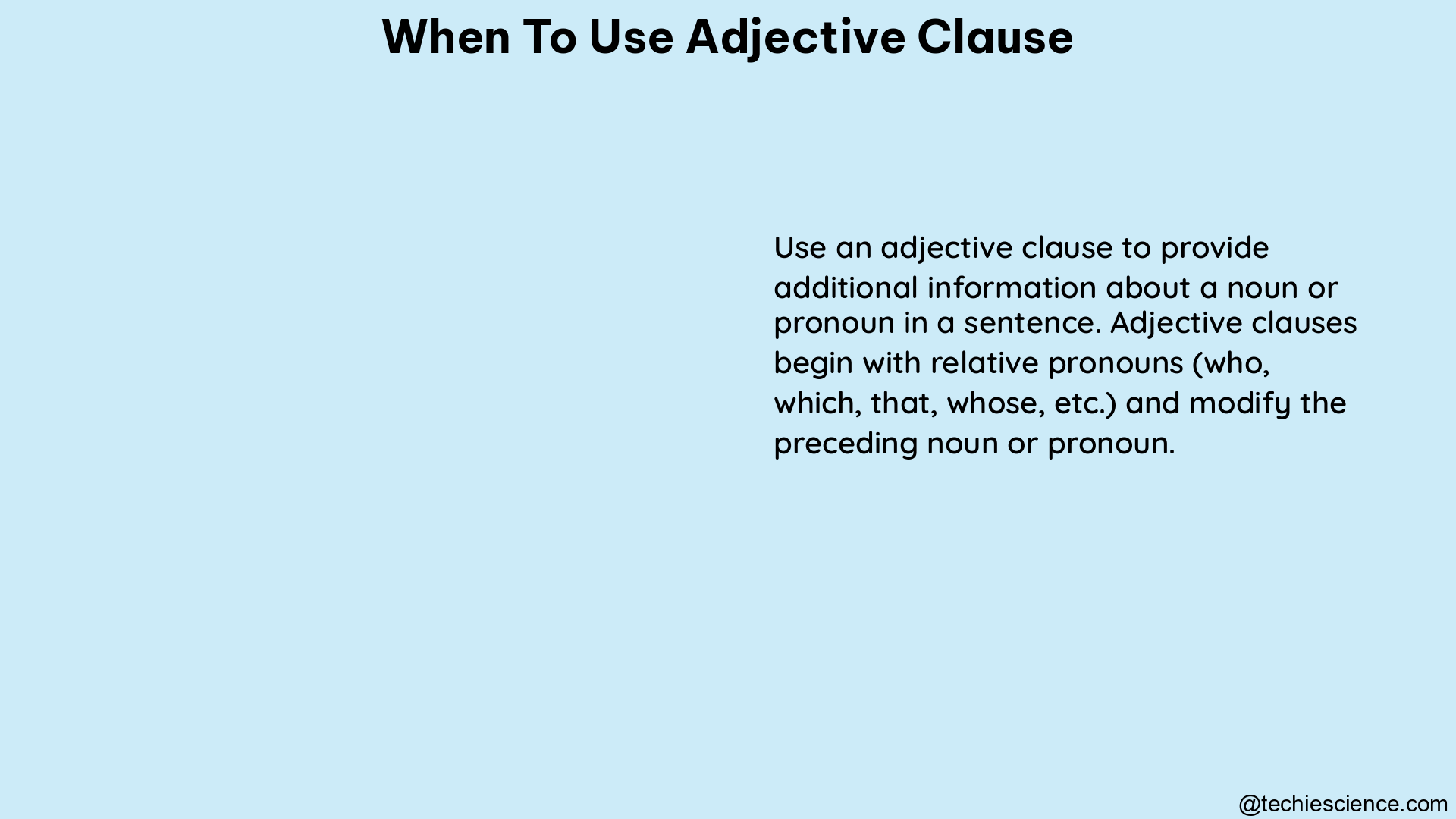Adjective clauses, also known as relative clauses, are a crucial component of English grammar that allow you to provide additional information about a noun or pronoun in a sentence. This comprehensive guide will delve into the advanced details and specific examples to help you master the art of using adjective clauses effectively.
Definition and Function of Adjective Clauses
An adjective clause is a dependent clause that modifies a noun or pronoun. It tells which one or what kind and provides more detailed information about the noun or pronoun it modifies. Adjective clauses almost always come right after the nouns they modify, making the sentence more informative and precise.
Using Relative Pronouns in Adjective Clauses

Adjective clauses typically begin with a relative pronoun such as that, which, who, whom, or whose. These pronouns connect the clause to the noun or pronoun it modifies and show the relationship between the clause and the antecedent.
Examples of Relative Pronouns in Adjective Clauses
- That:
- There is the mountain that we are going to climb.
-
The book that I read last week was excellent.
-
Which:
- My blue tennis shoes, which used to be my mom’s, were under the bed.
-
The book which is on the table is mine.
-
Who:
- Daniel, who was late again today, sits next to me in English.
- The people who live in the house are my neighbors.
Essential and Non-Essential Adjective Clauses
Adjective clauses can be classified as either essential or non-essential. An essential adjective clause is necessary for the sentence to make sense, as it provides crucial information about the noun or pronoun it modifies. On the other hand, a non-essential adjective clause provides additional information but is not necessary for the sentence to be understood.
Identifying Essential and Non-Essential Adjective Clauses
- Essential Adjective Clause:
- The book that I read last week was excellent.
-
The people who live in the house are my neighbors.
-
Non-Essential Adjective Clause:
- My blue tennis shoes, which used to be my mom’s, were under the bed.
- Daniel, who was late again today, sits next to me in English.
Combining Sentences Using Adjective Clauses
Adjective clauses can be used to combine sentences, making your writing more interesting and precise. To do this, you must:
- Remove a noun (or noun phrase) from one of the sentences.
- Replace it with a relative pronoun.
- Make sure the relative pronoun is at the front of the adjective clause.
- Insert the adjective clause into the other sentence, placing it directly after the noun it is describing.
Example of Combining Sentences with Adjective Clauses
- Original Sentences:
- The orange cat belongs to my neighbor.
-
The orange cat is pregnant.
-
Combined Sentence:
- The orange cat, which is pregnant, belongs to my neighbor.
Identifying Adjective Clauses in Sentences
Practice is essential for mastering the identification of adjective clauses. Here are some examples to help you get started:
- The book which is on the table is mine.
- The people who live in the house are my neighbors.
Common Words Used in Adjective Clauses
The following words are commonly used to introduce adjective clauses:
- who
- whom
- that
- which
- whose
- when
- where
- while
- why
- how
Formal and Informal Usage of Adjective Clauses
In formal English, it is generally better to put the preposition before the pronoun in an adjective clause. For example, “The book about which I spoke is on the table.”
In informal, spoken English, it is often acceptable to end the clause with the preposition or leave it out altogether. For example, “The book which I spoke about is on the table.”
Conclusion
Adjective clauses are a powerful tool in English grammar, allowing you to provide additional information about nouns and pronouns. By understanding the definition and function of adjective clauses, mastering the use of relative pronouns, and distinguishing between essential and non-essential clauses, you can enhance your writing and communication skills. Remember to practice identifying and using adjective clauses in your everyday writing and conversations to solidify your understanding.
References
- English Grammar 101. (n.d.). Clauses, Lesson 2: Adjective Clauses. Retrieved from https://www.englishgrammar101.com/module-10/clauses/lesson-2/adjective-clauses
- Grammarly. (2023). How to Use Adjective Clauses. Retrieved from https://www.grammarly.com/blog/adjective-clause/
- Synthesis. (n.d.). 7.4 GRAMMAR: Using Adjective Clauses. Retrieved from https://openoregon.pressbooks.pub/synthesis/chapter/7-4-grammar-using-adjective-clauses/
- Promova. (n.d.). Adjective Clause. Retrieved from https://promova.com/english-grammar/adjective-clauses-in-english
- QuillBot. (2024). Adjective Clause | Examples & Definition. Retrieved from https://quillbot.com/blog/adjectives/adjective-clause/
Hey! I am Arpita Bose Roy. My qualifications are M.A. in English with B. Ed. in both general education and special education. I have 2 years of experience as a “language analyst” at IIT Kharagpur and 4 years of experience as an “Academic Content Developer” at IIT Kharagpur. Currently, I am working as an academic writer at Lambdageeks.